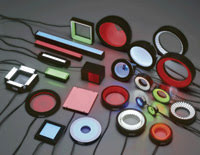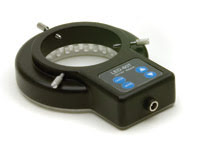Will 2009 be the year when LEDs replace other types in every application? We have become accustomed to dynamic LED message signs in doctors’ waiting rooms and outdoor sporting venues, and flashing lights on gaming machines. Nightclubs and restaurants are increasingly using decorative wall-wash and even underwater LED lighting. The EuroLED exhibition stressed the increasing use of LEDs in car headlights and general room lighting, and supermarket shelf lighting is already a big application area in the UK. But LED sources now also cater to every type of machine vision, microscopy and medical illumination situation.

Multipix has a comprehensive range of light sources for every type of machine vision application.
Alrad supplies LED lighting products from Austrian manufacturer Photonic Optics, high-power LED line lights from V Cubed in the UK and industrial illumination systems from the Swiss company Volpi AG. The latter is launching a high-power four-segment ring light for shadow-free illumination in stereomicroscopy. It focuses at various working distances to examine large or small objects and has adaptors to attach it to the main brands of microscopes. V Cubed uses water cooling to give its line lights extra power and fast warm-up, and the VLX2 Intelligent Line series comes in lengths of up to 2 m and more, with an operational lifetime of more than 50,000 hours. Controllability of output and intensity profile makes these really useful for web and surface inspection.
Multipix Imaging is another distributor of machine vision products; in his presentation at Photonex, Simon Hickman highlighted the IMAC range of LED sources. IMAC makes a full range of regular ring lights, line lights and backlights and also makes more unusual products. The “full colour” lighting range mixes different- colour LEDs in the one source, with individual intensity control for tuning the overall colour output. A mixed-colour dome light is particularly useful for the challenging application of inspecting solder and PCB boards. By switching individual coloured rings within the dome in sequence, a full picture of solder flow shape builds up in layers.
Still more uses
IMAC also makes several other unusual lights, such as a double-sided backlight for space-restricted inspection areas and a honey-coloured light range. The honey LEDs emit at 590 nm, which corresponds to the peak sensitivity for Sony Ex-view CCD sensors, making them ideal for very fast acquisition applications. They are also particularly suitable for inspecting photosensitive work such as a resist, which has been impossible to do with short-wave lighting in the past. Resists are photosensitive to light in the blue and ultraviolet. Honey-coloured LEDs do not emit these wavelengths.

Pyser SGI supplies the CL 15 LED ringlight from Optika. This is commonly used in stereo zoom microscopes, and the arrangement of LEDs in switchable segments gives better illumination control.
Neil Blackford of Pyser SGI told me: “The changeover to LED illumination in microscopes continues, as new higher-power LEDs become widely available. It is now common for new microscopes to offer an LED version and, indeed, some only come with the LED option.” The change is occurring right across the board, from low-cost educational microscopes to research-grade compound microscopes and some fluorescence microscopes, such as the N-400LD from Optika of Italy. In epifluorescence, LEDs provide a cold light source that needs no warm-up after switching on, and it lasts for 50,000 hours. There are still some challenges to be met. As yet, LEDs do not cover all the wavelengths of a mercury lamp, so there are currently some applications that cannot be served.